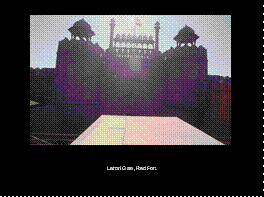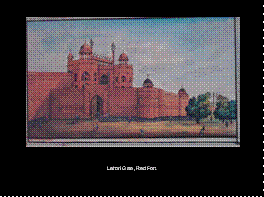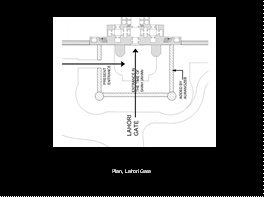The Most Magnificent Palace in the East: The Red Fort of Shah Jahan, the King of the World – A lecture delivered at the ATTIC, New Delhi By Anisha Shekhar Mukherji
Good Evening. I would like to begin my talk today on the Red Fort of Delhi, once called ‘The Most Magnificent Palace in the East’, with an image, which most of us present here―if not all of us―will instantly recognize. In fact, so would four year old children across the country who have just entered formal school!
This image is a part of the Red Fort’s outer walls. the Lahori Gate, to be precise, atop which the Indian Flag proudly waves. Each Independence Day, it is this view of the Fort that we salute, that is telecast through the country and routinely printed on the front pages of our newspapers. Ironically, however, this overwhelming focus on the Red Fort as a national icon bound so inseparably with the identity of independent India and its struggle for freedom against British rule, has actually directed attention away from its unique design. A design which has inspired at different times and varying levels, all manner of art and architecture within and beyond the Mughal Empire. Sikh religious buildings, Rajput palaces, residences of noblemen and of ordinary people.
Nonetheless today, despite the fact that the ‘Lal Quila’ is so deeply symbolic of not just Delhi but also of India, used to advertise products from Basmati rice to restaurants in Soho in London; for many of us the 15th August view is all there is to the Red Fort. We literally and figuratively stop short at its Lahori Gate, rarely bothering to proceed within it or wonder about its long and chequered historical existence. For instance, how many of us realise that even the familiar view with the mound and the ramparts from where the Prime Minister addresses the nation, is actually the antithesis of the Fort’s original design?! The original entrance to the Lahori Gate built three hundred and fifty years ago in the reign of the 5th Mughal Emperor Shah Jahan, was straight and open to view. It was not hidden by a wall or by a mound, in keeping with Shah Jahan’s actual and metaphorical accessibility to his people. The outer wall in front of the Lahori Gate which we see today in fact, reverses the very notion of the Fort’s original function and appearance. This wall as well as that in front of the other main public Gateway into the Fort, the Delhi Gate was made on the orders of Shah Jahan’s son, Aurangzeb, shortly after he defeated his brothers in the battle for the Mughal Throne, and imprisoned his ailing father at the Agra Fort. Shah Jahan is reported to have then written to him, “Dear Son, you have made the Fort a bride and put a veil upon her face..”
All representations of the Fort since then, whether in drawings of 19th century Delhi that we just saw, or the Delhi Tourism’s official calendars in the 20th century, have been defined by this forbidding veil in front of its public Gateways, which was made even more opaque by the British during their takeover of the Fort. This occurred in 1857, a little more than two hundred years after the founding of the Fort. I would like to draw aside this veil, which has obscured not just the physical view of the Red Fort’s interior, but also changed its relationship with its city of Shahjahanabad, and take you within the huge Fort today. To revisit the spaces in it and give you some idea of what it contained originally, what it symbolized in the Mughal way of life, why the pioneering British historian-explorer James Fergusson termed it the most magnificent palace in the East, what is its relevance today and how it should be regarded and conserved. This understanding of the Fort that I am going to present has been pieced together after sifting through the various depictions of its past existences available today including the Mughal dynasty’s court routine recorded in official court chronicles and Mughal miniature paintings, and personal diaries of individuals associated with the Fort, European travelogues, photographs and drawings and after studying the original Mughal structures that presently exist in the Fort. Interestingly, a map dating from the eighteenth century exists in the Oriental and India Office Collection at the British Library manner in which they exist today, with the original configuration.
The built structures have been shaded black in the plans of the Fort, before and after the destruction. A photograph of the area from the top of Jama Masjid shortly after the demolition also shows the empty spaces around the Fort, making it an island severed of its connecting links to Shahjahanabad.
TO BE CONTINUED…


